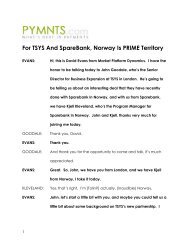Lydian Payments Journal - PYMNTS.com
Lydian Payments Journal - PYMNTS.com
Lydian Payments Journal - PYMNTS.com
Create successful ePaper yourself
Turn your PDF publications into a flip-book with our unique Google optimized e-Paper software.
European Monetary Union (EMU). These efforts led to the birth of the EMU in 1979. At that time, few<br />
economists gave it much chance of survival. 2 It not only survived, however, it grew and prospered.<br />
At the Hannover Summit of 1988, the European Council agreed to adopt the Single European Act, with the<br />
implicit objective of monetary integration. Mr. Delors, then President of the European <strong>com</strong>mission,<br />
re<strong>com</strong>mended a three‐stage plan to coordinate more economic and monetary policies with the intention of<br />
creating a European single currency under the stewardship of a European Central Bank. The three stages in<br />
de Delors plan incorporate the coordinating economic policy, achieving economic convergence and finaly<br />
the adoption of the euro, the EU's single currency. This report was known as the Delors Plan.<br />
The first stage of the Delors Plan began in 1990, and the European Council convened in Maastricht in 1991.<br />
There the Heads of State signed the Maastricht Treaty, which set out the tough economic convergence<br />
criteria that had to be met to qualify for the single currency. Next, the currencies of the non‐participating<br />
countries (pound sterling, the drachma, and the escudo) were brought into the exchange‐rate mechanism<br />
(notably, the pound sterling left the mechanism not much later). The second phase of the Delors plan was<br />
fuelled in 1994, with the creation of the so‐called European Monetary Institute (EMI).<br />
It was decided in May 1998 that 11 EU countries (Austria, Belgium, Finland, France, Germany, Ireland, Italy,<br />
Luxembourg, the Netherlands, Portugal, and Spain) satisfied the convergence criteria. Greece met these<br />
criteria very soon afterwards, so that it was ready to introduce the Euro on January 1, 2002 as the twelfth<br />
country. Also in 1998, the European Central Bank (ECB), the successor of the EMI, was erected. It became<br />
operational in 1999.<br />
The final stage of the Delors Plan, the adoption of the Euro, started on January 1, 1999. The parity rates<br />
were fixed irreversibly. As a consequence, national currencies were simply denominations of the Euro, but<br />
continued to be used as a matter of convenience. Full monetary union came into existence on January 1,<br />
2002 when the Euro was introduced in its physical form and when the national currencies were taken out<br />
of circulation. At this time, Slovenia (2007), Cyprus (2008), Malta (2008), and Slovakia (2009) have joined<br />
the Euro Zone, with EU members Denmark and the Baltic countries legally pegging their currencies to the<br />
Euro.<br />
There are many implications of the Euro adaptation. 3 The Euro led to reduced transaction costs (due to less<br />
need for currency conversion and hedging), simplified cash management, reduced cost of borrowing,<br />
2 B. Eichengreen. and C. Wyplosz. “The Unstable EMS,” Brookings Papers on Economic Activity 1 (1993): 51.<br />
© 2009. Copying, reprinting, or distributing this article is forbidden by anyone other than the publisher or author. 5








